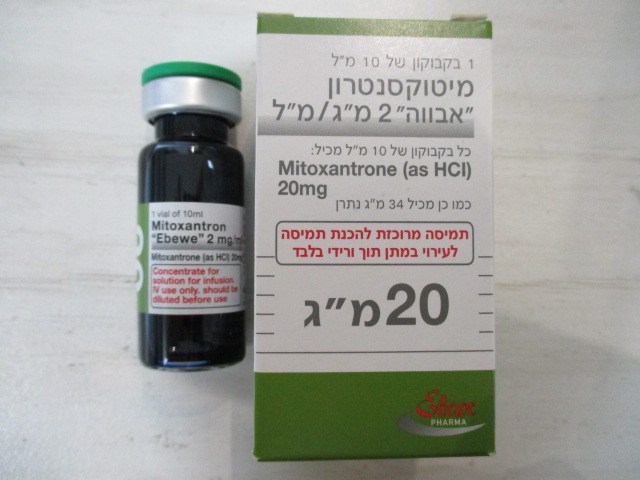Quest for the right Drug

מיטוקסנטרון "אבווה" 2 מ"ג/מ"ל MITOXANTRON "EBEWE" 2 MG/ML (MITOXANTRONE AS HYDROCHLORIDE)
תרופה במרשם
תרופה בסל
נרקוטיקה
ציטוטוקסיקה
צורת מתן:
תוך-ורידי : I.V
צורת מינון:
תרכיז להכנת תמיסה לאינפוזיה : CONCENTRATE FOR SOLUTION FOR INFUSION
עלון לרופא
מינוניםPosology התוויות
Indications תופעות לוואי
Adverse reactions התוויות נגד
Contraindications אינטראקציות
Interactions מינון יתר
Overdose הריון/הנקה
Pregnancy & Lactation אוכלוסיות מיוחדות
Special populations תכונות פרמקולוגיות
Pharmacological properties מידע רוקחי
Pharmaceutical particulars אזהרת שימוש
Special Warning עלון לרופא
Physicians Leaflet
Pharmacological properties : תכונות פרמקולוגיות
Pharmacodynamic Properties
5.1 Pharmacodynamic properties Pharmacotherapeutic group: Antineoplastic agents, Anthracyclines and related substances ATC- Code: L01DB07 Mechanism of action Mitoxantrone, a DNA-reactive agent that intercalates into deoxyribonucleic acid (DNA) through hydrogen bonding, causes crosslinks and strand breaks. Mitoxantrone also interferes with ribonucleic acid (RNA) and is a potent inhibitor of topoisomerase II, an enzyme responsible for uncoiling and repairing damaged DNA. It has a cytocidal effect on both proliferating and non- proliferating cultured human cells, suggesting lack of cell cycle phase specificity and activity against rapidly proliferating and slow-growing neoplasms. Mitoxantrone blocks the cell cycle in G2-phase leading to an increase of cellular RNA and polyploidy. Mitoxantrone has been shown in vitro to inhibit B cell, T cell, and macrophage proliferation and impair antigen presentation, as well as the secretion of interferon gamma, tumour necrosis factor alpha, and interleukin-2. Pharmacodynamic effects Mitoxantrone, a synthetic anthracenedione derivative, is an established cytotoxic, antineoplastic agent. Its therapeutic efficacy has been reported in numerous malignancies. Its presumed mechanism of action in MS is immunosuppression. Clinical efficacy and safety Treatment with mitoxantrone 12 to 14 mg/m² was effective in the treatment of various cancers. This dosage is given in 21 day-cycles, for induction therapy in AML during three consecutive days, for consolidation therapy during two days. Mitoxantrone is active when given alone or in combination with other anticancer agents or corticosteroids. Mitoxantrone in combination with other cytostatic active substances is effective in the treatment of metastatic breast cancer, also in patients who failed adjuvant therapy with an anthracycline- containing regimen. Mitoxantrone in combination with corticosteroids improves pain control, and quality of life in patients with advanced castrate resistant prostate cancer, without any improvement in overall survival. Mitoxantrone in combination with cytarabine as initial induction treatment is at least as effective for inducing remission as daunorubicin combinations in adult patients with previously untreated AML. Mitoxantrone alone or in combination with other cytostatic medicinal products shows objective response in patients with several types of NHL. The long-term usefulness of mitoxantrone is limited by emerging cancer resistance which ultimately may result in fatal outcome when used as last-line therapy. Treatment with mitoxantrone 12 mg/m² administered every three months was superior to 5 mg/m² and placebo in one clinical study with highly active inflammatory active MS disease. A reduction of neurologic disability worsening and frequency of clinical relapses was observed. In the several studies in multiple sclerosis the effective cumulative dose ranged from 36 mg/m2 to 120 mg/m2. Single doses ranged from 5 to 12 mg/m2, dose intervals from once per month to once per 3 months. Also the time course over which the cumulative dose was given ranged from 3 to 24 months. However, cardiotoxicity increases with cumulative doses. A cumulative dose of 72 mg/m² is still effective and associated with less cardiotoxicity than higher cumulative doses. Hence, patients with multiple sclerosis should not receive a lifetime cumulative dose greater than 72 mg/m². Paediatric population Safety and efficacy in paediatric patients have not been established.
Pharmacokinetic Properties
5.2 Pharmacokinetic properties Absorption The pharmacokinetics of mitoxantrone in patients following single-dose intravenous administration can be characterised by a three-compartment model. In patients administered 15- 90 mg/m2, there is a linear relationship between dose and the area under the concentration curve (AUC). Plasma accumulation of active substance was not apparent when mitoxantrone was administered either daily for five days or as a single dose every three weeks. Distribution Distribution to tissues is extensive: steady-state volume of distribution exceeds 1,000 L/m2. Plasma concentrations decrease rapidly during the first two hours and slowly thereafter. Mitoxantrone is 78 % bound to plasma proteins. The fraction bound is independent of concentration and is not affected by the presence of phenytoin, doxorubicin, methotrexate, prednisone, prednisolone, heparin, or aspirin. Mitoxantrone does not cross the blood-brain barrier. Distribution into testes is relatively low. Biotransformation and elimination The pathways leading to the metabolism of mitoxantrone have not been elucidated. Mitoxantrone is excreted slowly in urine and faeces as either unchanged active substance or as inactive metabolites. In human studies, only 10 % and 18 % of the dose were recovered in urine and faeces respectively as either active substance or metabolite during the 5-day period following administration of the medicinal product. Of the material recovered in urine, 65 % was unchanged active substance. The remaining 35 % was composed of monocarboxylic and dicarboxylic acid derivatives and their glucuronide conjugates. Many of the reported half-life values for the elimination phase are between 10 and 40 hours, but several other authors have reported much longer values of between 7 and 12 days. Differences in the estimates may be due to the availability of data at late times after doses, weighing of the data and assay sensitivity. Special populations Mitoxantrone clearance may be reduced by hepatic impairment. There does not seem to be relevant differences in pharmacokinetics of mitoxantrone between elderly and young adult patients. The effect of gender, race, and renal impairment on mitoxantrone pharmacokinetics is unknown. Mitoxantrone pharmacokinetics in the paediatric population is unknown.

שימוש לפי פנקס קופ''ח כללית 1994
לא צוין
תאריך הכללה מקורי בסל
01/01/1995
הגבלות
תרופה מוגבלת לשימוש בבתי חולים או אשפוז יום
מידע נוסף
